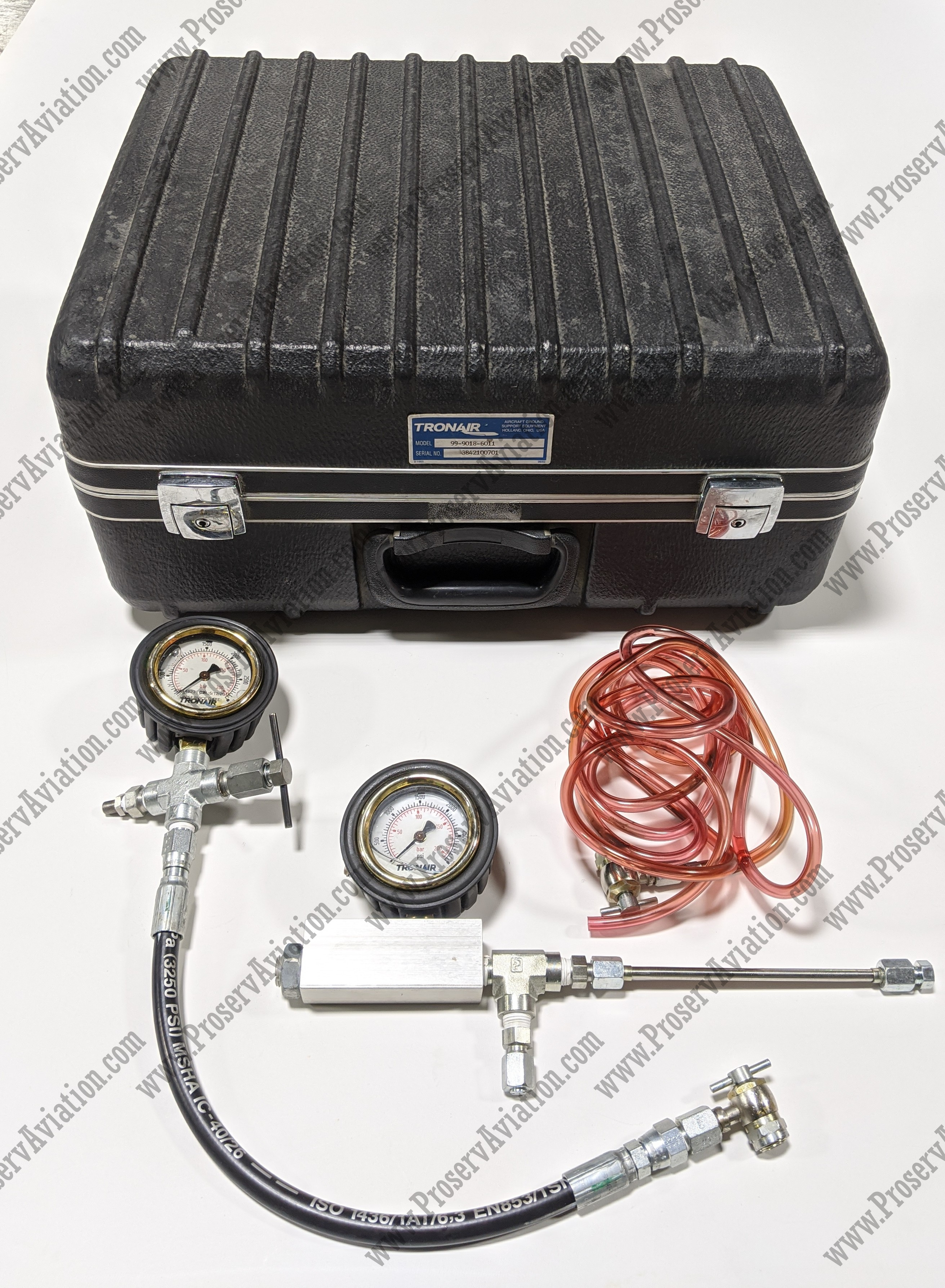Aircraft Strut Servicing - There are many different styles of vibrating cables, but most work in a similar way. The following discussion is general in nature. Refer to the manufacturer's maintenance instructions for information on the design, operation, and service of a specific aircraft shock absorber.
A typical pneumatic/hydraulic shock strut uses nitrogen in combination with compressed air or hydraulic fluid to absorb and dissipate shock loads. It is sometimes called an air/oil or oleo strut. Vibrating strings are made of two telescopic cylinders or tubes closed at the outer ends. The upper cylinder is attached to the aircraft and does not move. The lower cylinder is called the piston and is free to slide in and out of the upper cylinder. Two chambers are created. The lower chamber is always filled with hydraulic fluid and the upper chamber with compressed air or nitrogen. An opening located between the two cylinders provides a path for fluid to enter the upper chamber of the cylinder from the lower chamber when the strut is compressed. [Figure 1]
Aircraft Strut Servicing

Figure 1. Chassis damping strut with metering pin to control the flow of hydraulic fluid from the lower chamber to the upper chamber during compression.
Landing Gear Systems This Training Manual Has Been Prepared For Maintenance Technicians And Does Not Superseeded Information Contained In Applicable Aircraft.
Most dampers use a metering pin similar to the one shown in Figure 1 to control the rate of fluid flow from the lower chamber to the upper chamber. Fluid flow is not constant during the compression stroke. It is automatically controlled by the gauge tap in the hole. When the narrower part of the pin is in the hole, more fluid can enter the upper chamber. As the diameter of the metering pin part increases, less fluid passes through it. The compression of the strut and the pressure caused by pushing the hydraulic fluid through the gauge bore creates heat. This heat is converted into impact energy. It is scattered in the structure of the structure.
Some types of shock strings use a calibration tube. The working concept is the same as that of damper struts with metering pins, except that the holes in the metering tube control the flow of fluid from the lower chamber to the upper chamber during compression. [Figure 2]
Figure 2. Some suspension struts use an internal metering tube rather than a metering pin to control the flow of fluid from the lower cylinder to the upper cylinder.
When lifting or rebounding from compression, the damper struts stretch quickly. This can have a sharp impact and stroke damage at the end of the stroke. It is common for shock struts to have damping or damping devices to prevent this. A recirculation valve or recirculation tube on the piston restricts fluid flow during the extension stroke, slowing movement and preventing damaging impact forces.
Piper Flyer Association
Most shock absorbers are equipped with an axle as part of the lower cylinder for mounting aircraft wheels. At the end of the lower cylinder there is a provision for mounting the shock absorber axis without an integral axis. All damper strut upper cylinders are provided with suitable joints for attaching the strut to the airframe. [Figure 3]
The top cylinder of the damper strut usually contains the valve mounting assembly. It is located at or near the top of the cylinder. The valve provides a means to fill the strut with hydraulic fluid and inflate it with air or nitrogen as specified by the manufacturer. A packing is used to seal the sliding joint between the upper and lower telescopic cylinders. It is installed at the open end of the outer cylinder. A seal wiper ring is also installed on most vibration threads in a groove in the lower bearing or seal nut. It is designed to keep dirt, mud, ice and snow on the sliding surface of the piston from getting into the stuffing box and upper cylinder. Regularly cleaning the exposed portion of the strut piston helps the wiper do its job and reduces the chance of seal damage, which can cause a strut to leak.
To keep the pistons and wheels aligned, most shocks are equipped with torque couplings or torque bushings. One end of the connectors is attached to the fixed upper cylinder. The other end is attached to the lower cylinder (piston) so it cannot rotate. The wheels will thus remain assembled. When the strut is extended, such as after takeoff, the clutch holds the piston at the top of the cylinder. [Figure 4]

Figure 4. Torque couplings level the chassis and hold the piston in the upper cylinder when the strut is extended.
Spl 1829 Equipment
The front sprocket damping strut is equipped with a positioning cam assembly to keep the sprocket in alignment. A cam boss is attached to the lower cylinder and a matching lower cam is attached to the upper cylinder. This cam places the shock strut directly in front of the wheel and axle assembly when fully extended. This keeps the nose wheel well in the wheel when the nose gear retracts and prevents structural damage to the aircraft. It aligns the wheels with the longitudinal axis of the aircraft before landing when the strut is fully extended. [Figure 5] Most front wheel shock absorber strings have extensions for installing an external shock absorber. [Figure 6]
Figure 5. The upper cam is engaged with the lower cam when the nose landing gear damper strut is extended prior to landing and retracting the landing gear into the shaft.
The nose gear thread is often equipped with a locking or disconnect pin that allows the aircraft to turn quickly when the aircraft is being towed or placed on a ramp or trailer. Disconnecting this pin allows the wheel fork spindle on some aircraft to rotate 360°, allowing the aircraft to turn in a tight radius. At no time should the aircraft's nose wheel rotate beyond the limit marked on the airframe.
Most aircraft have nose dampers and main gear dampers, which are also equipped with lifting points and towing devices. Jacks must always be placed under the designated markings. If towing luggage is available, the tow bar should only be attached to that luggage. [Figure 7]
Maintenance, Restoration, And Repair
Figure 7. The gate on the chassis is a means for attaching the drawbar.
Damper struts come with an instruction label that tells you to fill the strut with fluid and inflate the strut. An instruction label is usually mounted near the filler hole and air valve assembly. It specifies the correct type of hydraulic fluid to use in the strut and the pressure to which the strut must be inflated. It is important to read these instructions before filling the shock absorber with hydraulic fluid or inflating it with air or nitrogen.
Damper Operation Figure 8 shows the internal structure of the damper. Arrows show fluid movement during strut contraction and extension. The shock's compression stroke begins when the aircraft's wheels touch the ground. As the aircraft's center of gravity moves down, the struts compress, pushing the lower cylinder or piston into the upper cylinder. The measuring pin therefore moves up through the hole. The pin cone controls the rate of fluid flow from the lower cylinder to the upper cylinder at all points during the compression stroke. In this way, the greatest amount of heat is dissipated through the walls of the strut. At the end of the downstroke, the compressed air in the upper cylinder is further compressed, limiting the compression stroke of the struts with minimal impact. During taxiing, the air in the tires and struts combine to smooth out bumps.

Figure 8. Fluid flow during damper operation is controlled by the metering pin cone in the damper bore.
Strut Service Kit, Nose Gear, Piper Pa 34 200 & 200t. (previously 104 Pppa34nssk)
A lack of fluid or air in the strut will cause the compression stroke to not be limited properly. The strut can go down, resulting in impact forces being transferred directly to the airframe through the strut's metal structure. A properly performed stroke will extend the stroke of the shock stroke operation at the end of the compression stroke. The energy stored in the compressed air in the upper cylinder causes the aircraft to move up relative to the ground and the lower strut cylinder as the strut tries to return to its normal position. Fluid is forced down through the restriction and damping holes back into the lower cylinder. Loss of fluid flow during extended stroke reduces strut recoil and oscillation caused by air spring action. A sleeve, spacer, or buffer ring built into the strut limits the extension stroke.
Damper struts require the correct fluid and air pressure to operate effectively
Oleo strut servicing, aircraft strut servicing tool, nfpa 407 standard for aircraft fuel servicing, aircraft nitrogen servicing cart, aircraft servicing, aircraft shock strut, aircraft strut pump, aircraft oxygen servicing, aircraft oxygen servicing equipment, aircraft strut, aircraft servicing equipment, servicing

0 Comments